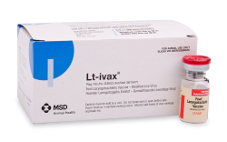LT-IVAX®

Modified live virus vaccine for use in chickens 4 weeks of age or older, as an aid in the prevention of chicken laryngotracheitis through vaccination by the eye drop method.
LT-IVAX®
Reg. No. G3603 (Act 36 /1947)
Namibia Reg. No. V03/24.3/742 [NS0]
INDICATIONS
Modified live virus vaccine for use in chickens 4 weeks of age or older, as an aid in the prevention of chicken laryngotracheitis through vaccination by the eye drop method.
COMPOSITION
LT-IVAX® vaccine contains a live virus of chicken tissue culture origin.
Each dose contains: 102,9 TCID50 chicken laryngotracheitis virus.
Preservative: Gentamycin sulphate
STORAGE INSTRUCTONS
Store between 2 °C and 7 °C.
WARNINGS
- Withdrawal period: Do not slaughter animals for human consumption within 21 days after vaccination.
- Vaccinate healthy chickens only.
- An eye reaction may be noticed if chickens are incubating coryza or other infectious organisms, or if there is excess ammonia or dust in the air of the housing facilities.
- Destroy any unused vaccine and dispose of all the empty vaccine containers and disposable equipment after use in accordance with National Environmental Management: Waste Act, 2008 (Act No. 59 of 2008).
- KEEP OUT OF REACH OF CHILDREN, UNINFORMED PERSONS AND ANIMALS.
- Although this vaccine has been extensively tested under a large variety of conditions, failure thereof may ensue as a result of a wide range of reasons, if this is suspected, seek veterinary advice and notify the registration holder.
PRECAUTIONS
- Avoid contact with eyes, hands and clothing when handling/administering the vaccine.
- Do not dilute the vaccine or otherwise stretch the dosage.
- Do not spill or spatter the vaccine.
- Use entire contents of each vial when first opened.
- Wash hands after vaccination.
CONTRA-INDICATIONS
The application of Newcastle Disease- or bronchitis vaccine, either singly or in combination should be avoided for a period of 3 days prior to and after the application of LT-IVAX®.
DIRECTIONS FOR USE – USE ONLY AS DIRECTED
In outbreak situations, vaccinate healthy chickens first, progressing toward outbreak areas in order to vaccinate diseased chickens last.
Vaccinate by the eye drop method according to the following schedule:
1. When to vaccinate
| Initial vaccination | Revaccination |
| 4 weeks of age | 10 weeks of age or older |
2. Vaccination programme
- The development of a durable strong protection depends upon the use of an effective vaccination programme as well as many circumstances such as administration techniques, environment and flock health at time of vaccination.
- Although disease may not be evident, coccidiosis, chronic respiratory disease, Mycoplasma infection, lymphoid leucosis, infectious bursal disease, Marek’s disease, or other disease conditions may cause serious complications or reduce protection.
- The immune response to 1 vaccination under field conditions is seldom complete for all chickens within a given flock. Even when vaccination is successful, the protection stimulated in individual chickens against different diseases may not be lifelong.
- If necessary, the vaccine may be used to aid in limiting the spread of an outbreak; however, only chickens not yet infected with the virulent outbreak virus can be protected.
- Examination of chickens for vaccination “takes” is unnecessary and so-called “takes” are not to be expected.
- As with all live virus vaccines, a mild transitory reaction may occur in a small portion of the flock, and with LT-IVAX®, this is generally limited to a mild, localised eye reaction of short duration.
3. Preparation of the vaccine
- Do not open and mix the vaccine until ready for use.
- Mix only 1 vial at a time and use entire contents within 2 hours.
- Remove the tear-off aluminium seal and stopper from vial containing the dried vaccine.
- Do the same for the diluent bottle and insert the long end of the adapter into the diluent bottle.
- Hold the diluent bottle firmly in an upright position and insert the vaccine vial on the adapter of the diluent bottle. The neck of the vaccine vial should snap into position and should be seated securely on the adapter on the diluent bottle.
- Invert the 2 containers so that the vaccine vial is on the bottom and allow the diluent to flow into the vaccine vial. If the diluent does not flow freely, squeeze the diluent bottle gently and the diluent will flow into the vaccine vial. The vaccine vial should be completely filled with diluent to prevent excess foaming.
- Hold the joined containers by the ends; shake vigorously until the vaccine plug has been completely dissolved.
- Return the joined containers to its original position (diluent bottle on the bottom).
- Allow the vaccine to flow into the diluent bottle. If the vaccine does not flow into the diluent bottle, tap or squeeze the diluent bottle gently and release to draw the vaccine into the diluent bottle. Ensure that all product is removed from the vaccine vial.
- Remove the vaccine vial and adapter from the neck of the diluent bottle and insert dropper applicator into the plastic diluent bottle.
- The vaccine is now ready for use.
- Wash hands thoroughly after mixing the vaccine.
4. How to vaccinate
- Hold dropper bottle in vertical position throughout vaccination to avoid wasting vaccine.
- Instill 1 full drop of rehydrated vaccine into the open eye of the chicken and hold until a swallowing motion is observed.
PRESENTATION
10 x 1 000 dose vials with 30 mℓ diluent.
REGISTRATION HOLDER
Intervet South Africa (Pty) Ltd.
20 Spartan Road, Spartan
1619, RSA
Tel: +27 (0) 11 923 9300
E-mail: msdahza@msd.com
www.msd-animal-health.co.za
DATE OF PUBLICATION OF THIS PACKAGE INSERT
18 February 2010
